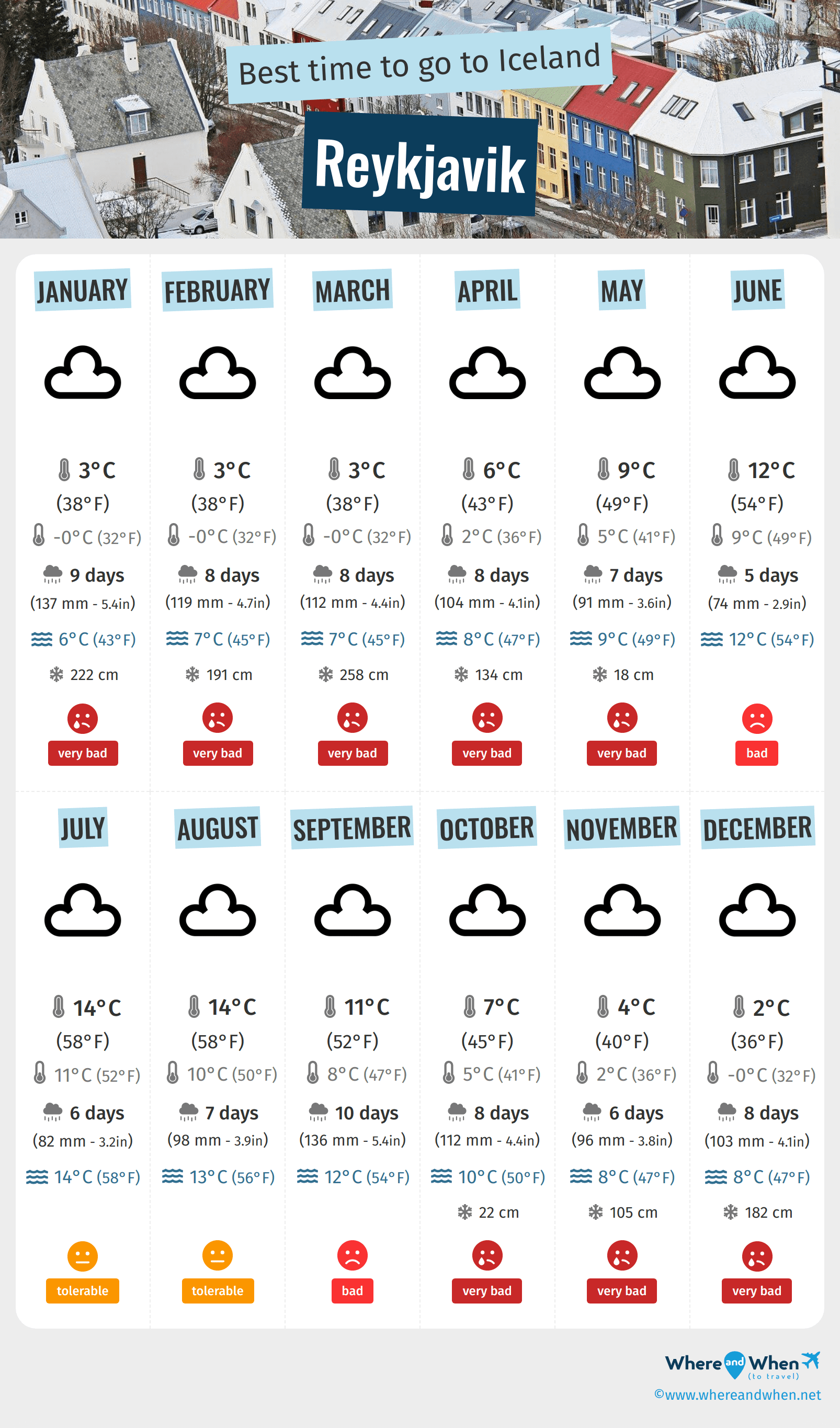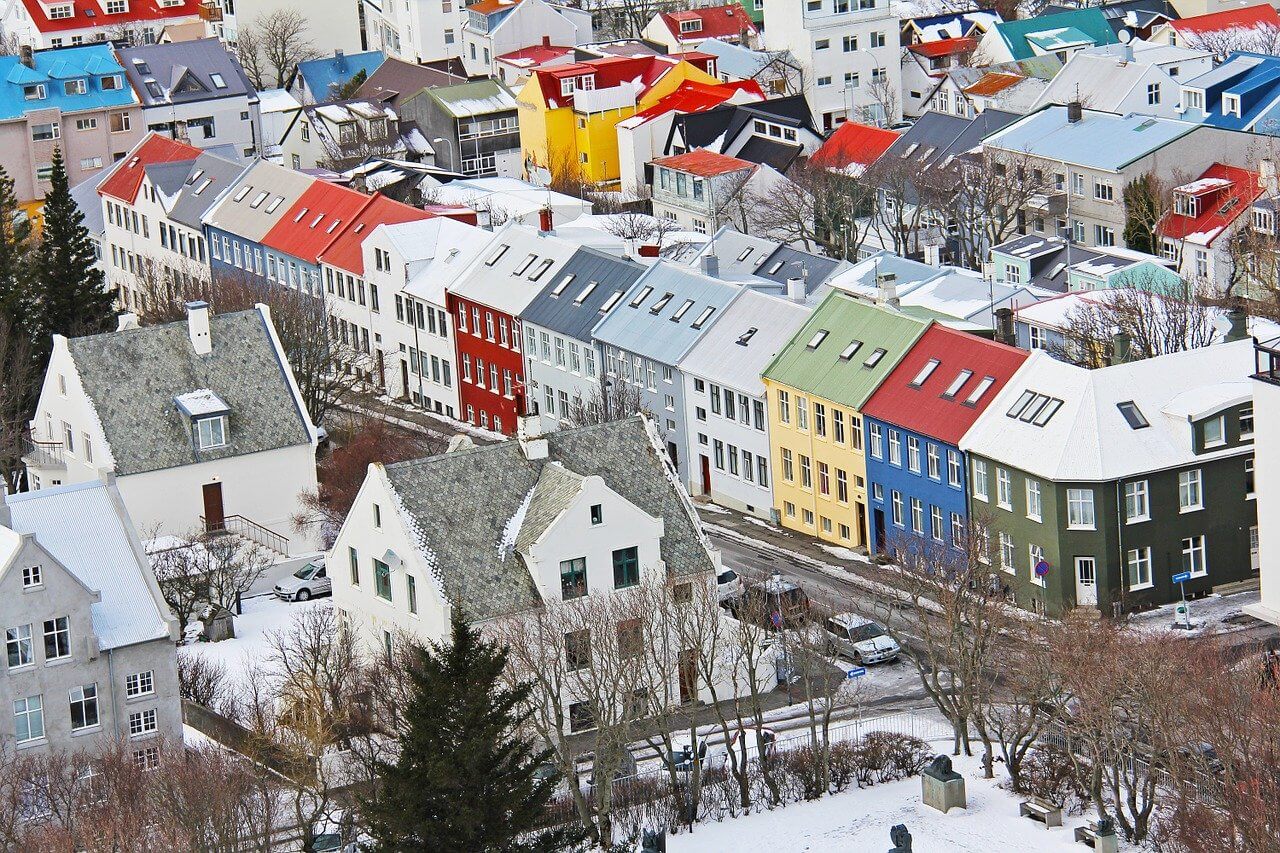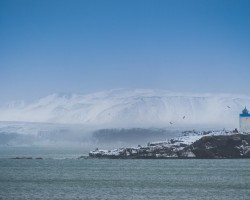Best time to go to Reykjavík Average weather of Reykjavík, Iceland
When is the best time to go to Reykjavík?
The best time to visit Reykjavík depends on what you are looking for in your trip. If you prioritize milder weather conditions and want to enjoy long sunny days, the summer period from June to August is the ideal time. This is also the high tourist season in Reykjavík. During this period, temperatures can reach 14°C (58°F) in July and August, which is considered cool compared to other European destinations, but it is the warmest period in Iceland.
However, during the high season, tourist sites can be crowded and accommodation prices tend to increase. Nevertheless, it is also a great time to enjoy many outdoor activities such as hiking, bird watching, and boat excursions to see whales.
If you are wondering when to go to Reykjavík to experience the unique phenomenon of observing the Northern Lights, then the period between November and March would be ideal. The nights are longer, providing perfect conditions to witness this spectacular natural phenomenon. However, be prepared for colder weather, with temperatures dropping to 0°C (32°F) in winter.
Visiting Reykjavík during less favorable periods, such as winter or autumn, can also have its advantages. Although the climate is harsher, with low temperatures and often cloudy skies, the city offers a picturesque winter landscape covered in snow. Additionally, tourist sites are less crowded, and accommodation prices are generally lower.
In conclusion, when to visit Reykjavík depends on your climate preferences and what you want to do during your stay. Whether it's to enjoy the long summer days, observe the Northern Lights, or discover the winter beauty of the city, Reykjavík will charm you at any time of the year.
So, when is the best time to go to Reykjavík? Here's some more information to help you in your decision:
- The best months in Reykjavík are July and August
- December is the coldest month of the year
- The rainiest months are January, February, March, September and October
Annual weather in Reykjavík

Weather details in Reykjavík month by month
Weather and climate in Reykjavík
Reykjavik, the capital of Iceland, is known for its oceanic climate, characterized by short and cool summers and long and cold winters. This type of temperate climate, classified as a short and cool oceanic climate (Cfc) according to the Köppen-Geiger classification, offers a variety of weather conditions throughout the year. The seasons are distinguished by noticeable changes in temperature, precipitation, and sky conditions. Here is an overview of what you can expect when visiting Reykjavik during the different seasons.
Winter in Reykjavik (December to February)
Winter in Reykjavik is characterized by cold temperatures, with lows reaching 0°C (32°F) during the day. The sky is generally cloudy, with occasional clearings. Snow is also common during this period, which can make the city even more picturesque. January is particularly cold, with an average temperature of 1°C (34°F) throughout the day.
Spring in Reykjavik (March to May)
In spring, temperatures begin to rise slowly, with lows ranging from 0°C (32°F) in March to 5°C (41°F) in May. Precipitation starts to decrease, although the weather remains generally cloudy with some clearings. In May, daytime temperatures can reach 9°C (49°F) .
Summer in Reykjavik (June to August)
Summer in Reykjavik is cool compared to other European destinations, with maximum temperatures reaching 14°C (58°F) in July and August. The days are longer and the sky is more often clear or slightly cloudy. July is the warmest month, with an average temperature of 14°C (58°F) at midday.
Autumn in Reykjavik (September to November)
Autumn sees a gradual drop in temperature, with daytime lows ranging from 8°C (47°F) in September to 2°C (36°F) in November. Precipitation also increases during this period, with the sky changing from slightly cloudy to mostly cloudy. November is particularly cold, with an average temperature of 3°C (38°F) throughout the day.
In conclusion, Reykjavik offers a variety of weather experiences throughout the year. Whether you prefer the icy cold of winter, the freshness of summer, or the milder temperatures of spring and autumn, there is always something to enjoy in the climate of this city. It is important to note, however, that the weather in Reykjavik can be unpredictable, so it is always advisable to check the weather forecast before planning your trip.

Charts: temperature and rainfall in Reykjavík
In the charts below, you can see the following seasonal norms for the city of Reykjavík: the minimum and maximum outdoor temperature, the risk and amount of monthly rainfall, daily average sunshine, sea temperature, and relative humidity for each month of the year.
Outside temperature
Precipitation (rainfall)
Daily sunshine hours
Sea temperature
Humidity
Peak visitor numbers and tourist seasons in Reykjavík
Find out when Reykjavík has its high tourist season (the period when the influx of tourists is highest) and off-peak tourist season using our data and figures.
Tourist seasons in Reykjavík
- Very low season in Reykjavík
The months with the lowest number of tourists are: January, March, April and November. - Low season in Reykjavík
The months with low numbers of tourists are: February, May, September, October and December. - High season in Reykjavík
The number of visitors to Reykjavík is high in: June. - Peak season in Reykjavík
The largest number of tourists visiting Reykjavík is during: July and August.
Figure: Visitor index for Reykjavík month by month
Best time for low prices in Reykjavík
Average prices of hotels in Reykjavík month by month
Generally, March is the month with the lowest hotel prices in Reykjavík. So this is a great time to save on your holiday! In contrast, July is statistically the most expensive month of the year for hotels.

Find the best price for your hotel room
Average price for flights to Reykjavík
A return flight between London and Reykjavík is generally cheaper if you go in january ($ 127 on average): this is the best time for travellers on a tight budget. In contrast, you may end up paying $ 173 more for your airline ticket to Reykjavík if you go in august.
Find the best price for your flight
Average price of hiring a car in Reykjavík
On average, it costs $ 63 per day to hire a car in Reykjavík. This price varies by $ 47 depending on the month. In january, hiring a car costs an average of $ 50 per 24 hours, so this is the best time to save money! In contrast, the average price in july is $ 96.
Other cities and places near Reykjavík


































































 Reykjavík
Reykjavík
 other locations
other locations




